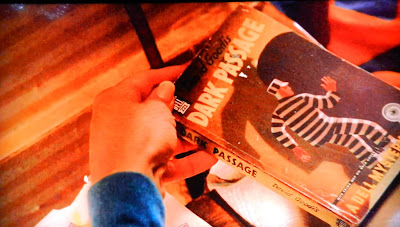Ron Faust published 15
novels in a career that spanned nearly 40 years. The first, Tombs of Blue
Ice, appeared in 1974 and the last, Jackstraw, was published
posthumously in 2013. His work never gained the commercial success it deserved;
maybe it was too atmospheric and literary for the genre crowd, and too
plot-driven for the literati. Or maybe he didn’t put enough titles on the
shelves, or maybe it was pure blind bad luck. Whatever the reason, his work is
deserving of a revival.
Faust’s work appeared
in three
distinct bursts. The first, and his most
productive as far as number of titles published, was between 1974 and 1981.
This period saw the publication of six novels, which tended to adventure with
exotic locations and solitary heroes. Lean, beautiful, descriptive prose,
linear storylines, and violence.
The final novel of
this early writing period is titled Nowhere to Run, and its publication
in 1981 would be Ron Faust’s last for 12 years. It is also one of a few Ron
Faust novels I hadn’t read, until very recently, and while it isn’t as mature
and ambitious as much of Faust’s later work—In the Forest of the Night, When
She Was Bad, etc.—it is an excellent adventure story with a strong sense of
place, character, and a beautifully nuanced awareness of humanity.
David Rhodes is
something of a bum. He was a professional tennis player, ranked as high as 147
in the world, living illegally in the Mexican coastal town of El Jardin de los
Reyes, Garden of the Kings. He makes a meager living teaching tennis and
raiding lobster traps. In the beginning, he meets an American girl who calls
herself Strawberry Lassitude—
“Her eyes seemed illuminated from within. They
were bright and metallic with craziness.”
—who is later found
strangled at the bottom of a rocky cliff. The local police, in the form of one
Captain Vigil, are desperate to solve the murder in a manner to reassure the
town’s primary economic driver: tourism. Specifically, American tourists. The
simplest solution. One American killing another, and, better, the killer an
illegal guest of the seaside town, which makes David the ideal suspect.
Nowhere to Run is stylistically flashy, thematically subtle,
and plotted for surprise. The natural, smooth flow of language is beautiful in
its sparse and rich tones. It equally defines the characters, the landscape,
and the story.
“Vigil half turned in his chair, raised a
hand, and when the waiter arrived he ordered two more bottles of the mineral
water. He smiled at David. He was not an ugly man until he smiled.”
“Brown pelicans folded their wings and made
clumsy crosswind landings in the troughs between waves. The tops of the coconut
palms were greenly incandescent in the sunlight but it was cool and dim in the
shade below. Here, there was a soothing opacity, a rippling underwater sheen,
while beyond the grove of trees the morning sun glazed the air and slowly
devoured the shadows it had created.”
Nowhere to Run is simple, or appears so at its surface. The
tale is straightforward—murder, man accused, and, after much turmoil, killer
exposed—but its simplicity is misleading. The story is dependent less on plot
than character. The actions of the characters, and the motive for those
actions, are dominant and the plot becomes a rational extension to that
dominance rather than the characters a prisoner of the plot. Its language is
sharp, almost poetic in its descriptive prowess, and its building blocks are
human morality, psychology, and frailty. The psychology, and morality, and
frailty, are summarized quite nicely in the closing pages—
“He had spent most of that evening in the
lounge of the Hotel El Presidente, drinking and playing liar’s poker with a
couple of his pals. They had gambled with one-hundred-peso notes and Harry had
lost about forty dollars. Not much money, but enough to sour his mood a little;
he had never learned how to accept losing, hated it, regarded it as a little
death—every time you lost, whether a dime or an argument or what the Asians
call face, a chip was taken out of your self-esteem and you entered the next
contest with that much less confidence. Losing was an accumulative poison like
lead or arsenic; small doses did not appear to cause much harm, but they
collected and in time…”



























